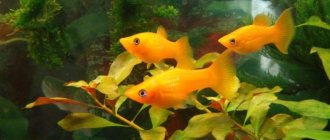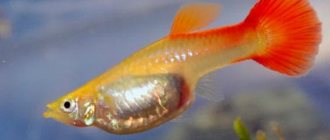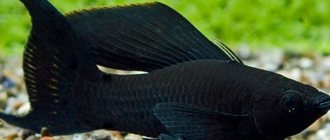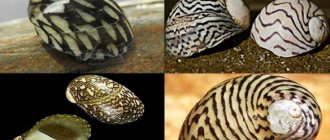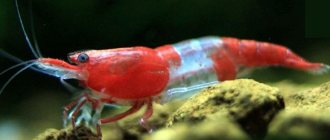Mollies are a popular aquarium fish, distinguished by their richly colored scales and easy-going nature. Many aquarists keep the phenotype both in a separate and in a species tank, and of course, they breed mollies. Before embarking on such a responsible task, you should know how aquarium fish reproduce, how mollies directly give birth, and how to raise mollies fry at home.
General characteristics of the species
Mollies are aquarium fish from the genus Poeciliidae, belonging to the order Cyprinodontiformes. The main feature of the phenotype is that molly is a viviparous fish, and is capable of bearing and giving birth to offspring that are completely ready for independent life immediately after birth. In the wild, molly fish look modest and inconspicuous, but in pet stores, thanks to the painstaking work of breeders, you can see many different ornamental fish species that differ in color and body shape. The color of molly scales varies from jet black to white and orange, and the body shape can be disc or balloon.
Interesting fact: only this species can have a “balloon” body shape. In balloon mollies, reproduction occurs in the same way as in other relatives.
Natural habitat
Mollies are an aquarium fish of the genus Poeciliidae. In the natural environment, these fish quickly adapt, easily find food for themselves and are perfectly compatible with sea and river inhabitants. These fish were brought to Europe in the 20th century from the South American continent. The breeding of these “settlers” began in the 40s. Hybrids began to appear at the beginning of the 20th century. Their population is growing day by day.
It's nothing special. Its natural color is gray-silver, black spots are distributed throughout the body, darkening is located around the eyes of the mollies. It looks like an ordinary fish, but aquarium inhabitants are a completely different matter. The aquarium fish market is full of variety. They come in different colors: silver, orange, variegated, white. These peaceful inhabitants of the aquatic environment are not at all aggressive and have good health.
Advice: for beginners, you need to make a choice in favor of small fin mollies and its hybrids. They can live longer in small aquariums. And, compatibility with other fish makes this species practical and unique.
Features of reproduction
Spawning of mollies can take place only at 5–6 months in females, and at 8–12 months in males, since it is at this age that the fish begin puberty. To avoid hassles, aquarists choose not a couple of molly fish for breeding, but four individuals: one male and three females. After a pregnant molly gives birth, fertilized eggs remain in its body, and even if the breeding male is removed from the aquarium, the females can still reproduce. In a pregnant molly, birth occurs after 20–40 days, the duration depends on the water temperature. Also a distinctive feature of the phenotype is the ability to change sex if the preservation of the population requires it.
Fish diseases
In most cases, diseases of mollies, like all viviparous fish, are caused by improper care. To prevent this from happening, they need to be carefully looked after.
Causes of the disease:
- Overfeeding.
- Infections.
- Colds.
- Poor quality water change.
- Improper transportation of fish.
The main signs of the disease in fish:
- Small bubbles form on the body or a fluffy area on the scales is detected.
- Dark spots, swelling or traces of white spots are visible on the fins.
- Bug-eyed fish is an infectious disease. The cause may be infection or poor care.
Based on these signs, a primary diagnosis can be made. “Goggle eyes” is more of a symptom than a disease.
Types of fish diseases:
- Melanosis (the color of the fish changes). The pigment becomes more pronounced, degenerating into a tumor.
- Ichthyophthirius (in owners of mollies, the fish was covered with white spots, similar to semolina).
- Bacterial diseases (damage to one or another type of bacterium):
- Fungal diseases (caused by fungi): these are moss, cotton wool, fluff on the body of the fish. If the fin turns white and is covered with semolina, then the diagnosis is obvious.
- Flagellates and ciliates - spots, rashes, holes.
- The mollies swim upside down or have changed the angle of movement. The cause may be a stone or foreign body.
- One or both eyes are bulging. Visually the eye comes out of its socket. Protrusions are observed very pronounced with clouding of the eyes. This indicates exophthalmos. The fish may lose sight and die.
Various poisons accumulate in the aquarium: nitrates and nitrites, ammonia. These dangerous substances reduce the fish’s immunity. It is extremely difficult to cure it. If measures are not taken, she will die.
In this case you need:
- Regularly replace old cloudy water with clean, fresh water.
- Conduct a test to determine the oxygen content in aquarium water. This will also help determine the presence of NH4, NO3, NO2 in it. Bring the indicators back to normal.
- White spots on mollies can be removed by raising the temperature of the water in the aquarium, adding salt or antibiotics. The white coating that covers the scales of the fish is nothing more than a fungus.
If your fish has bulging eyes, the cause may be an infection. And she will need longer treatment.
Treatment
In pet stores you can find various medicines against various diseases, the main thing is to determine the symptom correctly. All diseases arise due to the mistakes of beginners, namely violation of the rules of their maintenance:
- Filtration;
- Aeration;
- Volume of the aquarium.
The most commonly used drugs for diseases:
- Tetra Contralck – from ciliates, flagellates (ichthyophthyriasis, semolina, white spots).
- Sera bakto Tabs – against internal bacterial infections.
- Before using medications, you must pay attention to the description of their properties in the instructions.
Prevention
To avoid illness, it is important to pay attention to maintenance standards. Learn about prevention methods:
- Replace dirty and stale water.
- Clean the aquarium.
- Monitor the temperature in the tank.
How to distinguish a female from a male
Before you breed molly, you need to be able to distinguish between male and female molly. Experienced aquarists are guided by the following external signs:
- boys are smaller in size, the anal fin is presented in the form of a genital organ, and the caudal fin is lush and large;
- girls are larger and more plump, and the anal fin has a triangular shape.
The sex of a fish can be determined at 6–8 weeks of life, and its formation depends on the temperature of the liquid in the general aquarium: boys predominate in warm water, and females predominate in cold water.
Conditions necessary to produce healthy offspring
In most cases, the reproduction of mollies occurs without difficulty, however, it will require the owner of these cute creatures to create comfortable conditions.
To successfully breed new generations of mollies, you will need:
- Spacious aquarium.
- Pure water without impurities, enriched with oxygen.
- The presence of shelters in the form of snags, dense thickets, rocky areas.
Pregnant female.
Breeding mollies in a community aquarium is not recommended. When the female’s pregnancy becomes obvious, the fish will need to be placed in a vessel with a volume of 60-100 liters of warm water (within 25-28 degrees). It is advisable to do this a few days before the expected “birth”.
The imminent arrival of this moment will be indicated by the behavior of the aquarium fish itself. Most often, the female begins to actively look for a place where she can safely hide. If babies begin to be born soon, the shape of the abdomen changes noticeably - from round it becomes square .
The aquarium should be rich in thick algae. The female must be transplanted very carefully so as not to provoke premature spawning. Proper maintenance of pregnant mollies involves a varied, rich diet. The omnivorous nature of the fish allows you to offer it live, plant or dry food.
Before labor occurs, it is important to constantly monitor the water temperature. If the reading is more than 28°C, the fry may be born premature, which significantly reduces their chances of survival.
Preparing fish for breeding
Mollies give birth and reproduce only in certain conditions, otherwise pregnancy may not occur, or the offspring will be premature. You can breed fish in a common aquarium, but experts advise placing the parents in a separate container so that nothing distracts or disturbs the pets. The spawning tank is prepared as follows:
- volume is selected from 60 l;
- living vegetation is planted in the nursery;
- daylight hours should last 12 hours;
- water acidity – 7–8 pH;
- hardness – 20–30 dH;
- temperature – 26–28C.
To obtain healthy offspring, the best fish are selected, among which there should be three females and one male. The selection is made according to the following criteria:
- pet activity and mobility;
- fin integrity;
- brightness and uniformity of color, absence of stains or plaque;
- fish size;
- belonging of future parents to the same species.
Before transplanting the fish into the nursery, it is necessary to keep the future parents on plant feeding for two weeks. Mollies begin breeding one or two months after moving to the spawning ground: the male fertilizes the female using the genitals, and the first attempts may be unsuccessful.
Interesting fact: Molly fry are almost always born at dawn.
Black mollies
Most often, only black, selective varieties of mollies are found on sale these days. But the marks of black molly, as they are called by amateur aquarists, usually contain a small number of spotted fry, in which black scales alternate with light and greenish-bluish ones, like the natural form.
Relatively recently, a variety of forked mollies with a notched caudal fin and long upper and lower rays, and scarf mollies with an elongated dorsal fin, were bred.
How to determine pregnancy
Considering the fact that fertilization does not occur the first time, many aquarists are thinking about how to determine the pregnancy of mollies. It should be noted that only producers of the same species need to be crossed in order to obtain uniformly colored and beautiful offspring. In pregnant mollies, the abdomen is significantly rounded and protrudes, so it is easy to notice the interesting position of the fish. Breeding fish can produce offspring within six months after mating, since fertilized eggs are stored in their bodies. Before giving birth, the fish becomes anxious and restless, begins to rush around the aquarium, and the abdomen takes the shape of a rectangle. Mollies give birth on average in 3–6 hours, producing each baby in turn, and it is extremely important not to miss the moment when molly fry are born - from 10 to 200 pieces. The fact is that the mother poses a threat to the babies, since she is not averse to feasting on the offspring, so the fish are quickly put into the old reservoir.
Interesting fact: the number of babies born depends on the size of the mother.
Aulophorus
Aulophorus worms are an excellent valuable and nutritious food for mollies fry. In the first week, the aulophorus for mollies fry will be still large, so before feeding it, it must be crushed, cut with a blade on a small piece of rubber or glass, then washed in a net made of thick fabric. Breeding Aulophorus is not difficult. Aulophorus is bred on foam sponges, placing them in a low plastic container with a closing lid. Sponges are placed in a container and filled with aquarium or tap water so that the upper part of the sponges remains 2-3 mm unflooded with water.
A cast of worms is placed on the surface of the sponges, sprinkled with food and covered with a lid. To feed Aulophorus you can use: grass flour, boiled carrots, spirulina or crushed rolled oats. It is believed that the best results are obtained from crushed rolled oats (oatmeal). The culture of worms must be allowed to multiply and for 2-3 weeks the aulophorus is only fed, adding fertilizer as it is eaten and the water is changed every 1-2 days.
Changing the water is carried out by lightly squeezing the sponges directly in the container by lightly pressing and replacing the water several times. Aulophorus worms remain in the drained water; to filter them, you need to drain the water from the container through a net made of dense fabric (tulle, organza, veil). The collected worms can be returned to the sponge or fed to the fish. Worms are collected for feeding with tweezers and washed in a net. If the worms are clean without any additives, they don’t need to be washed. Read more about breeding Aulophorus...
Caring for fry
Small born mollies are independent and mobile, but despite this, caring for the fry is necessary. The main thing for growing viable and healthy fish is information on what to feed molly fry and how to care for the babies.
Molly offspring reach 7 mm in length, however, the endurance of the species is much less than that of other phenotypes, so it is important to look after the molly fry at first. After birth, the babies lie on the leaves or ground for some time, and then begin to move in search of food. Feed small molly 3-4 times a day, giving small portions of the following foods:
- Daphnia;
- tubifex;
- Cyclops;
- crushed dry food;
- Artemia;
- microworms;
- ciliates.
Vinegar eel
The easiest live food to breed at home is the vinegar eel. Acetic eel has additional names: microfeed, microworm and nematode. To breed eel, you will need a shallow plastic container with a closing lid. The vinegar eel feeds on the vinegar produced when flour products, such as bread or oatmeal, sour.
For feeding, you can use oatmeal porridge or just soaked bread. Making oatmeal porridge is very simple. Rolled oats flakes ground in a coffee grinder should be brewed with boiling water and cooled. The resulting mass should resemble batter. To increase carotene in the worm, you can add grated carrots to the feeding.
